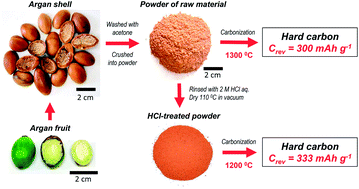Synthesis of hard carbon from argan shells for Na-ion batteries†
Abstract
Hard carbon is an attractive material for negative electrodes in sodium-ion batteries. Herein, we report a new hard carbon synthesized via carbonization of argan shell biomass, which delivers an enhanced capacity higher than 330 mA h g−1 based upon reversible sodium insertion. We prepared hard carbon under different high-temperature treatment and biomass pretreatment conditions. The graphitization degree of the hard carbon increased as the carbonization temperature increased; simultaneously, the reversible capacity for sodium storage was significantly influenced by the carbonization temperature. Structural characterization revealed differences in the structures of the hard carbons synthesized at different carbonization temperatures, which elucidates the correlation between the increased capacity and the micropore size available for sodium storage. The composite electrodes containing the argan hard carbons with a sodium polyacrylate binder were tested in non-aqueous sodium half cells. The electrodes delivered reversible capacities as high as 300 mA h g−1 at a current density of 25 mA g−1 with superior reversibility and capacity retention of 94.1% after 70 cycles. By carbonization of argan shell biomass treated with HCl aqueous solution, we successfully demonstrated a higher reversible capacity of 333 mA h g−1 and an excellent capacity retention of 96.0% after 100 cycles.



 Please wait while we load your content...
Please wait while we load your content...